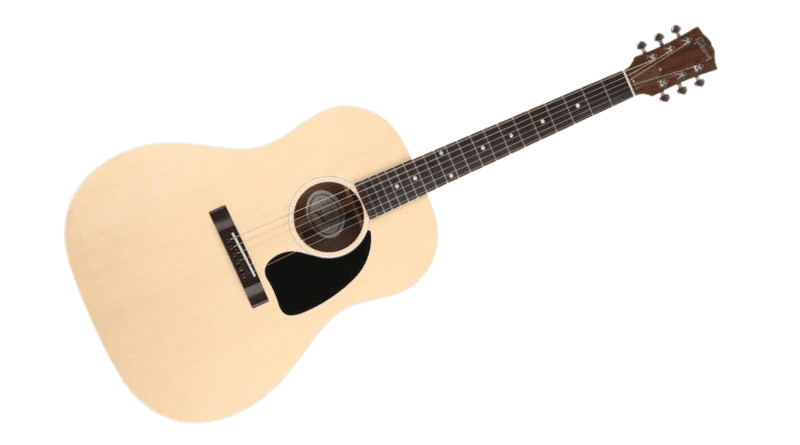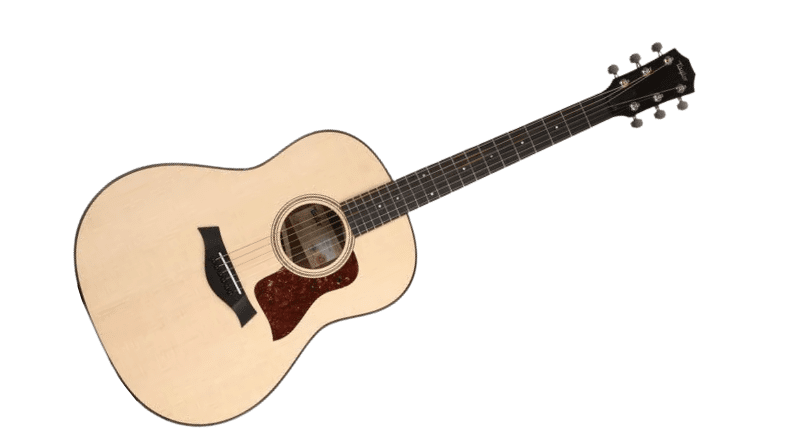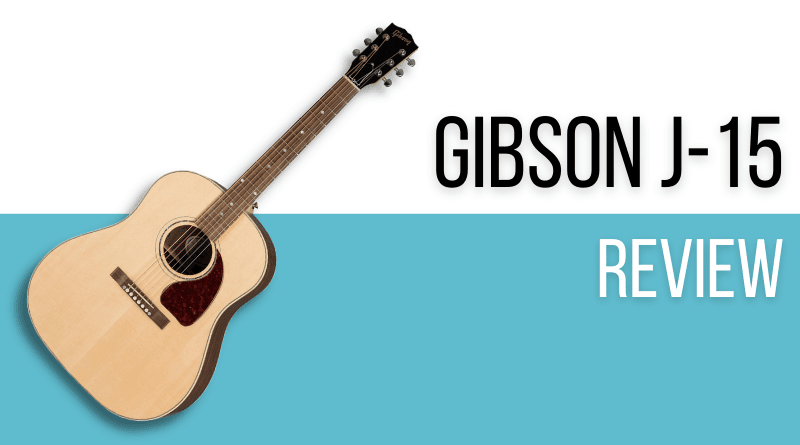The Gibson J-15 was a short lived model that was produced from 2014 to early 2019. Despite the fact that it’s no longer available as a new product, it’s taken on an almost cult following in certain circles of acoustic guitarists, but what made it so special?
Keep reading to find out as we get hands on with a J15.
Read more about our review process.
Contents
Who Is This For?
The Gibson J-15 is suitable for everybody from outright beginners with a bit of cash to spend, right through to working musicians, both in the studio and on the stage. It’s a high quality, US made guitar, and while it costs quite a bit more than the average beginner instrument, it’s one that you’ll easily be able to keep for life (if properly looked after).
Appearance / Features / Controls
We absolutely loved the look of the J-15 – this one of Gibson’s famous “round shoulder” models, which are in our opinion, some of the most beautiful acoustic guitar designs ever made. It had the presence of a dreadnought, but the slight slope on the upper bouts really helps to differentiate it from almost every other guitar out there. Put simply, there’s no mistaking this for anything other than a Gibson.
As for construction, it was made with a solid Sitka spruce top, which is by all accounts a fairly common tone wood on mid to high end acoustics, the back and sides, however, were made with American walnut, which is a bit more unusual.
The solid maple neck had a comfortable slim taper profile and a really nice satin finish. We never found ourselves getting hung up on it, even after extended play.
It was equipped with some really excellent hardware, too. The tuners were Grover Mini Rotomatics, which just like their full size counterparts, gave us rock solid tuning stability and great fine control. It featured a Tusq saddle and a Tusq nut, both of which contributed heavily to both the tuning stability, intonation, and the excellent tone.
We especially loved the LR Baggs Element pickup. It beautifully captured the character of the J-15, and the sound hole mounted volume control kept the looks clean.
This was, while still available new, Gibson’s most affordable acoustic, so it wasn’t too surprising to find that it wasn’t quite as nicely finished as some of their more high end models. From the outside, fit and finish were superb, both from a looks and feel perspective, but looking through the sound hole, we noticed that the bracing wasn’t very nicely finished, and was frankly a little rough. It didn’t affect tone in the slightest, but as this isn’t exactly a cheap guitar, we’d have hoped for a smoother finish, even on the interior.
Performance/Sound
The Gibson J-15 looks great, but we thought it sounded even better. We spent a long time playing all different styles on this guitar, and with each passing minute became more and more confused as to why Gibson discontinued this model.
Fingerstyle is where the J-15 really shines. When picked hard, it was easily one of the brightest acoustics we’ve ever played at any price point. Despite the incredible top end, it was also hugely present in the mid range. The mids helped it stand out on its own as a solo instrument, but that dazzling top end really kept it shining through in a mix.
The one area in which this guitar was lacking was at the bottom end. While is still sounded great, the overall volume was somewhat hampered by the lack of bass in the sound profile.
When strummed, the J-15 had a dry, almost husky tone that really complimented vocals – the change in dynamics between fingerstyle and strumming was quite special, turning from an incredibly bright tone, to an earthy mellow sound. This is one of the main factors that has kept this model so popular with singer-songwriters, despite having been out of production for several years now.
It was absolutely brilliant in the studio, too. With close mic recording, the incredible harmonics really stood out, and when plugged and recording through the pickup we were impressed to see that it still retained its acoustic character. There were no preamp controls other than volume, but we didn’t find ourselves needing on board EQ anyway
Other Guitars to Consider
The Gibson J-15 is a genuinely brilliant guitar, but because it’s no longer in production, buying one means buying used, which is something not everybody is happy to take a risk on at this price point. Check out these alternatives if you’re interested in a US made acoustic guitar for between $1000 and $1500.
Gibson G-45 Natural

The Gibson G-45 (full review here) has the same shape and dimensions as the popular J-15, and is even made with the same wood selection (Sitka spruce top, walnut back and sides), yet, it plays quite differently. One of the biggest differences is that it has a thicker neck than the J-45, using Gibson’s Advance Response profile. The G-45 also features the new Gibson Player Port, a second sound hole located on the bass side upper bout. This is said to allow the player to hear a truer representation of the guitar’s sound.
Gibson have cut costs for the G-45 by changing out some of the more premium appointments, but the construction quality is still high, and the tone remains unaffected by the changes. A new G-45 will cost around $300 less than a used J-15, making it a great deal if you’re set on a new guitar.
Taylor American Dream AD17

The Taylor American Dream AD17 offers similar looks and materials to the Gibson J-15, and can be found new for about the same price. It’s made with a solid Sitka spruce top, and features back and sides made from ovangkol, which is a West African rosewood.
Like the J-15, it offers a wonderful top and mid range, and is also beautifully appointed with high end materials and hardware. It features a eucalyptus wood fretboard and bridge, which have a very similar appearance to ebony, but are a much more sustainable choice.
Final Thoughts on the Gibson J-15
Overall, considering its position at the base of the Gibson acoustic lineup, the J-15 looked like a premium, US made guitar. It had binding, genuine mother of pearl inlay, and beautifully grained wood. Compared to Martin and Taylor’s entry level US made models, and even the current base model Gibson G-45, the J-15 is, at least, aesthetically, the obvious choice.
It was a sonically diverse guitar, and we loved how easily we could change from a sharp attack with incredible brightness, to a more relaxed, mellow tone. Sadly, as it’s now discontinued, you’ll need to buy used if you’ve decided to go for a J-15, but if you find a good one, it’s definitely worthwhile.
Check out these other awesome acoustic guitar articles:


